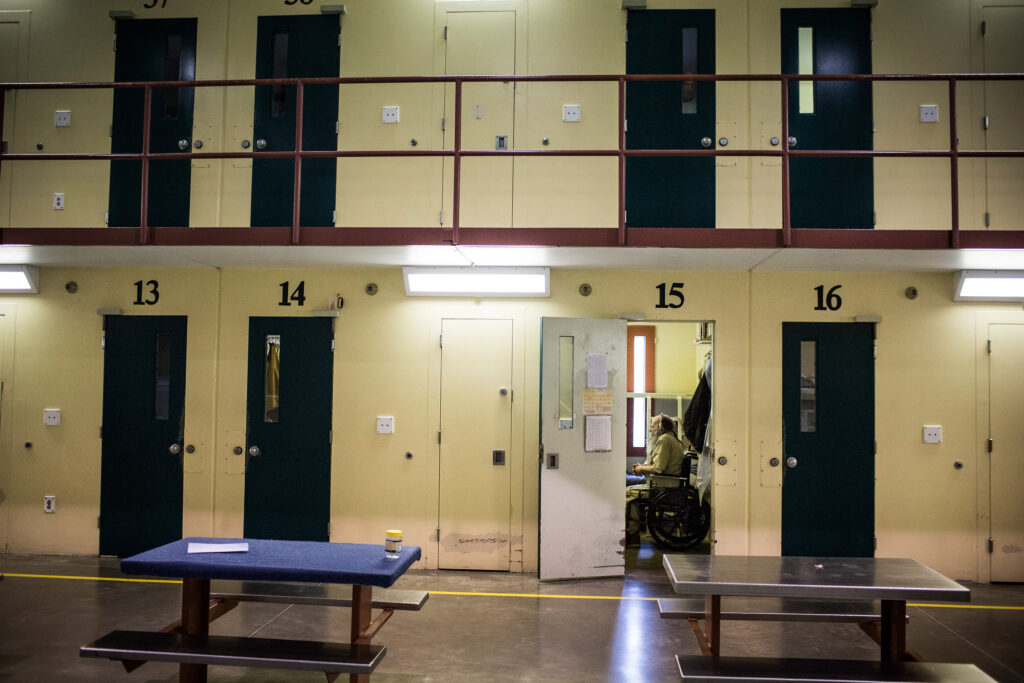While sweltering heat in prisons without air conditioning has long been an issue in the South, extreme heat waves worsened by climate change are expanding the problem into Northern states.
In recent years, Michigan, Minnesota, South Dakota, Washington and Wisconsin have seen extreme heat in prisons. Many of these states lack the necessary infrastructure for ventilation or cooling systems capable of managing extreme heat.
“This is not at all an issue that’s confined to what we all think of as the hot states,” David Fathi, director of the ACLU National Prison Project, said in an interview with Stateline. “While it may be more common, or more of pressing a problem in the Southern states and the states of the Southwest, this is now truly a national problem.”
Some advocates have argued that hot conditions in prisons constitute “cruel and unusual punishment” prohibited by the Eighth Amendment. The conditions have led to lawsuits and protests across the country.
The decision not to air condition these facilities is essentially a decision to let people die.
– David Fathi, director of the ACLU National Prison Project
The lack of air conditioning amid rising temperatures creates challenges for prisons: possible heat-related illnesses, increased violent incidents and high staff turnover, according to experts and advocates.
To address these problems, some states are offering alternative cooling methods such as cooling beds and increased access to water stations or ice; others have allocated funding toward upgrading or building new facilities with air conditioning.
Most states, however, have taken little to no action, advocates say.
“The absence of air conditioning in prisons and jails is a disaster waiting to happen,” Fathi said. “This is not an issue of comfort or luxury, it is an issue of life and death. … The decision not to air condition these facilities is essentially a decision to let people die.”

Impact on incarcerated people and visitors
A study published in March by PLOS One and written by researchers affiliated with Brown University, Boston University and Harvard University suggests that extreme heat is causing fatalities within prisons across the United States, offering one of the first pieces of epidemiological evidence linking the climate crisis to prison mortality. The study also revealed elevated rates of mortality in the Northeast region.
The researchers analyzed deaths in both state-run and privately run prisons during June, July and August from 2001 to 2019. They found that a 10-degree temperature increase above the average correlated with a 5.2% increase in deaths or a 6.7% increase in deaths related to heart disease.
The study also found that a two-day heat wave correlated with a mortality increase of 21% in the Northeast, compared with 0.8% in the Midwest, 1.3% in the South and 8.6% in the West.
People in prison are increasingly vulnerable to heat-related illnesses, according to David Pellow, the director of the Global Environmental Justice Project at the University of California, Santa Barbara.
The prison population is aging, and about 40% of incarcerated people report having a chronic medical condition, according to estimates released by the Bureau of Justice Statistics. Mental health problems are also prevalent across the prison population. Psychotropic drugs, which are used to treat some mental illnesses, can exacerbate heat sensitivity because they “reduce the body’s ability to naturally regulate heat and cool down,” Pellow wrote in an email.
Roy Rogers, who spent almost 30 years in Wisconsin’s correctional facilities — including the Columbia Correctional Institution and the Green Bay Correctional Institution — said the inmates’ living quarters were not air-conditioned. In some cases, inmates relied on manually opening and closing windows for ventilation.
“To put it plainly, it sucked,” said Rogers, who now sits on the board of directors for the Wisconsin Justice Initiative, a criminal justice reform group, in an interview with Stateline. “When you get to the extreme heat, there’s really not much that is done for those who are incarcerated.”
While there is not universal air conditioning in Wisconsin’s facilities, the majority are equipped with “some kind of air handling system that circulates air throughout the buildings,” according to Kevin Hoffman, the deputy director of communications for the Wisconsin Department of Corrections. The department’s current administration plans to include tempered air systems in upcoming construction and renovation projects, Hoffman wrote in an email to Stateline.
Rogers said personal fans are considered a “high luxury” among incarcerated individuals, but the fans sold to inmates are often too small and cheaply made to be effective against the blistering heat.
“They really do nothing for you. If the air around you is hot, the only thing you will accomplish is blowing around more hot air,” Rogers said. “It’s going to end up being like 90 or close to 100 [degrees] in your room.”
Inmates’ limited financial means, often constrained by wages ranging on average from 14 cents to $1.41 per hour, according to a 2017 analysis by the Prison Policy Initiative, further complicate their ability to access cooling resources. Fans sold in some state prison commissaries can cost about $20.
Some prisoners resort to extreme measures to seek relief, Rogers said, even opting for solitary confinement in segregated cells with cooler temperatures.
When you get to the extreme heat, there’s really not much that is done for those who are incarcerated.
– Roy Rogers, Wisconsin Justice Initiative
Moreover, the scorching conditions can create a volatile atmosphere that fosters aggression and escalates potentially violent incidents.
“The extreme heat is not good for anyone,” he said. “The staff [is also impacted], so they are more agitated. They are more inclined to handle the residents a little bit more roughly than usual. … It elevates the overall atmosphere in a prison to a real volatile level where it makes it unsafe for everybody.”
The heat also affects visitors.
When Kehaulani Walker visited her husband last summer at the Monroe Correctional Complex in Washington state, the heat was “unbearable.” The complex only has air conditioning in its Special Offender Units, according to the Washington State Department of Corrections.
“It affected us to the point where I’ve left visitation a few times because we would be sweating so bad,” Walker, an activist and the founder and CEO of the group Families of the Incarcerated, said in an interview with Stateline. “We really couldn’t have an actual true visitation because both of us were drenched in sweat, and we were focusing on the heat more than we could focus on each other.”
During one of her visits, Walker also noticed a correctional officer dozing off in the heat — something she said is a safety issue.
Staff, infrastructure lacking
Some advocates say extreme heat is fueling staff turnover and staffing shortages in state prisons.
A report released in 2022 by the New Jersey Office of the Corrections Ombudsperson said around 3,500 prisoners were housed in units with no air conditioning, while 3,000 correctional officers were assigned to work in those areas.
“The office also heard reports from staff and labor leaders that high heat increased irritability and slowed responses to prison security incidents,” the report said. “Incarcerated people and staff universally suggested that air-conditioning and other building repairs were badly needed.”
At least 44 states lack universal air conditioning within their prison facilities, even in regions known for sweltering summer temperatures, according to a 2022 USA Today investigation.
In some instances, non-air-conditioned areas include living quarters, while air-conditioned spaces might be designated for correctional officers, heat-vulnerable individuals or specific units like solitary confinement. Alaska is the only state without air conditioning across any of its facilities.
An article published in 2022 in the Fordham Urban Law Journal found that chronic understaffing in correctional facilities will worsen because of climate-induced hazards and economic pressures. It also said deteriorating facilities pose heightened dangers as they’re more susceptible to extreme heat, flooding and other catastrophic climate and weather events.
“Facility-related hazards caused by climate-related stress will become more dangerous and disruptive as the frequency and amplitude of extreme weather increase,” the article said.

How states are responding
Some states, including those in northern parts of the country, are taking steps that range from cooling system installations to temporarily lifting uniform policies.
South Dakota installed air conditioning in some of its newer facilities, including the women’s prison and work release centers, and is planning the development of a new men’s prison equipped with air conditioning. Uniform restrictions were lifted in Florida, allowing inmates to don shorts and single-layer shirts. State authorities have also undertaken repairs on broken water fountains and provided cool water kegs as measures to alleviate the effects of heat.
The Montana State Prison in Deer Lodge will receive $200 million in infrastructure upgrades. The funding, approved by the state legislature, will go toward upgrading low-security housing and updating technology such as locks and video surveillance systems.
The prison, which was built in the 1970s, did not have air conditioning installed when it was built, according to the Montana Department of Corrections. Any necessary HVAC or air conditioning upgrades will be evaluated during the prison’s remodel of its D-Unit and low-security housing rebuild, the department said.
The Montana Women’s Prison, which does have air conditioning, will get $750,000 to upgrade its cooling system, Alexandria Valdez Klapmeier, the department’s public information officer, wrote in an email.
In Oregon, where residents grappled with a heat wave in 2021, the Oregon State Correctional Institution, a medium security prison in Salem, sold inmates $18 cooling towels. The towels were purchased by the prison for $9.35 each, a nearly 100% markup. A spokesperson for the Oregon Department of Corrections told the Willamette Week, a local weekly newspaper, that proceeds would go toward new sports equipment for the facility’s inmates.
In Washington, there are five HVAC system upgrade projects that received legislative funding for the Monroe Correctional Complex, the Washington Corrections Center for Women, the Washington State Penitentiary and the Progress House Work Release.
“Recent excessive heat events have been unusual; the good news is that staff and incarcerated individuals, overwhelmingly keep a positive outlook, and recognize the efforts that staff and incarcerated make to mitigate the effects of the heat,” Tobby Hatley, Washington State Department of Corrections’ media relations manager, wrote in an email. “Our facilities are prepared if another heat wave should occur.”
Stateline is part of States Newsroom, a nonprofit news network supported by grants and a coalition of donors as a 501c(3) public charity. Stateline maintains editorial independence. Contact Editor Scott S. Greenberger for questions: [email protected]. Follow Stateline on Facebook and Twitter.
This post was originally published on this site be sure to check out more of their content.








